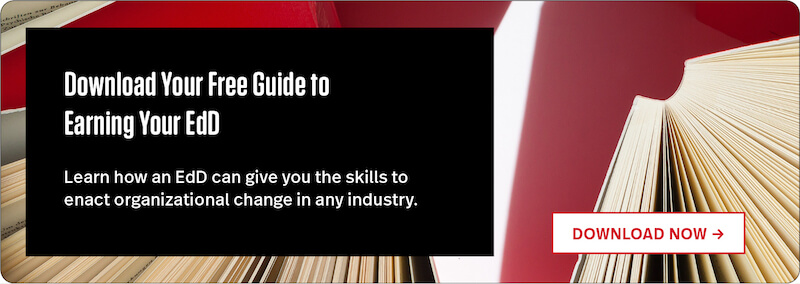For professionals in higher education, learning how to anticipate, recognize, and minimize legal risks and threats is a crucial skill.
“The vast majority of people don’t need to know everything about every law,” says Joseph McNabb, a professor within Northeastern University’s Graduate School of Education. “But you need a baseline understanding of how certain laws impact higher education in order to help you make better decisions.”
Institutions of higher education operate in a complex legal environment that includes laws related to financial aid, admissions, licensure, and privacy. Failure to adhere to these laws can result in costly lawsuits, negative attention, and loss of federal resources.
“At Northeastern, our goal is to prepare student affairs professionals, advisors, deans of students, and other higher ed professionals to recognize these legal issues and deal with them in an informed way,” McNabb says.
The most common legal issues that higher education professionals encounter include ones pertaining to discrimination, accessibility, free speech. Read on to learn how four of these laws are applicable to colleges and universities.
Download Our Free Guide to Earning Your EdD
Learn how an EdD can give you the skills to enact organizational change in any industry.
Common Legal Issues in Higher Education
Title IX
Title IX of the Education Amendments of 1972 protects people from discrimination based on sex in education programs or activities that receive federal financial assistance. According to the U.S. Department of Education (ED), these agencies include approximately 7,000 postsecondary institutions.
Some key areas in which higher education institutions have Title IX obligations include:
- Recruitment, admissions, and counseling
- Financial assistance
- Athletics
- Sex-based harassment
- Treatment of pregnant and parenting students
- Discipline
- Single-sex education
- Employment
For example, a higher education institution may be in violation of Title IX if it offers an athletic team for one sex without an alternative option for the other. Other violations might include preventing a pregnant student from participating in classes or extracurricular activities; failing to follow rules and procedures for reporting and enforcing policies on sexual assault; and failing to protect students who face negative consequences, increased harassment, or disciplinary measures because they filed a Title IX complaint or lawsuit.
Real-World Example
In 2012, a college student, identified as John Doe, attended a student newspaper event on a cruise ship. While the student crossed a crowded dance floor, another student was sexually assaulted, turned around, saw him, and assumed it was his fault. Doe was arrested, and college officials found him responsible before the criminal investigation concluded. Video of the night ultimately showed that Doe was not at fault, and the case was dismissed. Last year, a jury found that Doe was denied a fair process, which was in violation of Title IX, and he was awarded more than $100,000 in damages.
Americans with Disabilities Act (ADA)
Under Title II and Title III of the Americans with Disabilities Act, both public and private colleges and universities must make their programs accessible to students with disabilities. This includes accommodations for extracurricular activities, as well as any in-class requirements.
To meet this requirement, higher education institutions must provide disabled students with:
- Fair access to buildings, including residential facilities
- Aids and services necessary for effective communication, such as sign language interpreters or Braille formats
- Modified policies, practices, and procedures, such as testing accommodations and access to school facilities for service animals
Violations of the ADA might include being asked to disclose whether you have a disability, being denied admission based on your answer to that question, or being excluded from a particular class, program, or activity based on your disability.
Real-World Example
In 2015, advocates for the deaf filed a federal lawsuit against a renowned Ivy League university, saying that the institution failed to provide closed captioning in their online lectures, courses, podcasts, and other educational materials. Last year, the university reached a settlement, agreeing to pay attorney’s fees totaling more than $1.5 million and take steps to improve the accessibility of content posted to its official website and associated media platforms.
First Amendment
The First Amendment to the U.S. Constitution explains that “Congress shall make no law […] abridging the freedom of speech.” In higher education, the First Amendment restricts the right for public colleges or universities to regulate expression.
The right to free speech is most often called into question in times where an institution might try to manage speech that is offensive, McNabb says. According to the Freedom Forum Institute, other issues with free speech in a higher education environment may also stem from:
- Outspoken faculty
- Visiting speakers who express controversial views
- The use of student fees to support LGBTQ organizations
- Reporting or editorializing in a student-run newspaper
- Artistic expression.
Higher education institutions must balance the requirements of free speech with issues of civility and respect.
Real-World Example
In a lawsuit filed in January, a university was accused of violating the freedom of speech of a group of its students when it shut down a peaceful gun rights demonstration on campus. Students dressed in orange jumpsuits posed as criminals while holding signs that mockingly supported “gun-free zones.” While the students were protesting in a common outdoor area on campus, a university office ordered them to stop, which infringed upon their right to free speech.
Affirmative Action
Affirmative action refers to a set of policies that support members of disadvantaged groups that have previously suffered discrimination, including minorities and women. In higher education, affirmative action has been heavily debated in admissions. Some colleges and universities have adopted policies that seek to increase the recruitment of racial minorities. In 2003, affirmative action as a practice was upheld by the Supreme Court, while the use of racial quotas for college admissions was ruled unconstitutional.
Real-World Example
Last year, in a case that drew widespread scrutiny, a federal judge rejected claims that an Ivy League-institution had intentionally discriminated against Asian-American applicants. An advocacy group argued that the university had violated federal civil rights laws by holding Asian-Americans—who, as a group, have been found to earn better test scores and grades than other races—to a higher standard. The institution in question was accused of downgrading applications from Asian-Americans based on a subjective rating system that was vulnerable to stereotyping.
Real-world scenarios like the one above are incorporated into courses like McNabb’s within Northeastern’s Doctor of Education program. “These are the sorts of things we talk about in class,” he says, adding that one of his students attended the proceedings for this exact case at the federal court. “She was able to see it in real life and discuss the applicability of it with us.”
For professionals seeking a career in higher education, the topic of legal issues is just one of the many subjects that the Doctor of Education program explores.
Learn more about how a Doctor of Education program can shape your career today with your free eBook at the link below.







Related Articles
What is Learning Analytics & How Can it Be Used?
Reasons To Enroll in a Doctor of Education Program
Why I Chose to Pursue Learning Analytics